Difference in Strength Development between Cement-Treated Sand and Mortar with Various Cement Types and Curing Temperatures
Abstract
1. Introduction
2. Materials and Measurements
2.1. Materials and Specimens
2.1.1. Mix Proportions, Mixing and Compaction
2.1.2. Curing Conditions
2.2. Measurements
2.2.1. Unconfined Compressive Strength
2.2.2. Thermal Analysis
3. Results and Discussion
3.1. Compressive Strength
3.1.1. Compressive Strength of Mortar
3.1.2. Compressive Strength of Cement-Treated Sand
3.1.3. Effects of Cement Content on Strength Development under Different Curing Conditions
3.1.4. Relationship between Compressive Strength and Maturity Index
3.2. Thermal Analysis
3.2.1. Determination of Chemically Bound Water in Ground Cement Paste
3.2.2. Amount of Chemically Bound Water (WCB)
4. Conclusions
- An elevated curing temperature accelerated the early age strength development of both cement-treated sand and mortar specimens that contained HPC, OPC and MPC. However, the effect of temperature on the development of strength at the later age depended on the cement material used. Specifically, a higher temperature reduced the strength of the HPC mortar and cement-treated sand specimens, as well as that of the OPC mortar specimens, whereas it enhanced the strength of the OPC and MPC cement-treated sand specimens.
- For the HPC specimens, the normalized compressive strengths increased as the cement content decreased between mortars with W/C values of 50% and cement-treated sand with 8% cement. At the age of 3 days, the normalized value for the HPC-treated sand specimens is nearly twice the corresponding value for the HPC mortar specimens with W/C values of 50%. At the age of 28 days, the normalized value for cement-treated sand with 8% cement is approximately 1.5 times higher than that of mortar with a W/C value of 50%. The normalized values at an early age were greater than those at a later age. These findings indicated that the contributions of HPC were more significant for cement-treated sand than for mortar, and had a greater effect on the early age than the later-age strength.
- The maturity index expressed accurately the strength development of the OPC and MPC mortar and cement-treated sand specimens. However, the strength development of the HPC specimens could not be expressed with this index for either mortar or cement-treated sand.
- The higher compressive strength of the HPC-treated sand can be explained by the higher quantity of chemically bound water (24.1% at 91 days) owing to the higher alite content, higher water-to-cement ratio, and higher porosity of the specimens compared with those (13.4% and 18.6% at 91 days) of the OPC- and MPC-treated sand.
Author Contributions
Funding
Acknowledgments
Conflicts of Interest
References
- Horpibulsuk, S.; Rachan, R.; Chinkulkijniwat, A.; Raksachon, Y.; Suddeepong, A. Analysis of strength development in cement-stabilized silty clay from microstructural considerations. Constr. Build. Mater. 2010, 24, 2011–2021. [Google Scholar] [CrossRef]
- Subramanian, S.; Khan, Q.; Ku, T. Effect of sand on the stiffness characteristics of cement-stabilized clay. Constr. Build. Mater. 2020, 264, 120192. [Google Scholar] [CrossRef]
- Kang, G.; Tsuchida, T.; Athapaththu, A. Engineering behavior of cement-treated marine dredged clay during early and later stages of curing. Eng. Geol. 2016, 209, 163–174. [Google Scholar] [CrossRef]
- Kitazume, M.; Terashi, M. The Deep Mixing Method; CRC Press: Boca Raton, FL, USA, 2013. [Google Scholar]
- Omura, T.; Murata, M.; Hirai, M. The influence of strength due to hydration heat on-site measurement results and curing temperature of deep mixing. In Proceedings of the 36th Japan Society of Civil Engineers Annual Meeting, Hiroshima, Japan, 6–8 October 1981; pp. 732–733. (In Japanese). [Google Scholar]
- Zhang, R.J.; Lu, Y.T.; Tan, T.S.; Phoon, K.K.; Santoso, A.M. Long-term effect of curing temperature on the strength behavior of cement-stabilized clay. J. Geotech. Geoenviron. Eng. 2014, 140, 04014045. [Google Scholar] [CrossRef]
- Lemaire, K.; Deneele, D.; Bonnet, S.; Legret, M. Effects of lime and cement treatment on the physicochemical, microstructural and mechanical characteristics of a plastic silt. Eng. Geol. 2013, 166, 255–261. [Google Scholar] [CrossRef]
- Wang, D.; Zentar, R.; Abriak, N.E. Temperature-accelerated strength development in stabilized marine soils as road construction materials. J. Mater. Civ. Eng. 2016, 29, 04016281. [Google Scholar] [CrossRef]
- Arabi, M.; Wild, S. Microstructural development in cured soil-lime composites. J. Mater. Sci. 1986, 21, 497–503. [Google Scholar] [CrossRef]
- Chew, S.H.; Kamruzzaman, A.H.M.; Lee, F.H. Physicochemical and engineering behavior of cement treated clays. J. Geotech. Geoenviron. Eng. 2004, 130, 696–706. [Google Scholar] [CrossRef]
- Horpibulsuk, S.; Rachan, R.; Suddeepong, A. Assessment of strength development in blended cement admixed Bangkok clay. Constr. Build. Mater. 2011, 25, 1521–1531. [Google Scholar] [CrossRef]
- Nakarai, K.; Yoshida, T. Effect of carbonation on strength development of cement-treated Toyoura silica sand. Soils Found. 2015, 55, 857–865. [Google Scholar] [CrossRef]
- Escalante-Garcıa, J.I.; Sharp, J.H. The microstructure and mechanical properties of blended cements hydrated at various temperatures. Cem. Concr. Res. 2001, 31, 695–702. [Google Scholar] [CrossRef]
- Brooks, J.J.; Al-Kaisi, A.F. Early strength development of Portland and slag cement concretes cured at elevated temperatures. ACI Mater. J. 1990, 87, 503–507. [Google Scholar]
- Kim, J.K.; Han, S.H.; Song, Y.C. Effect of temperature and aging on the mechanical properties of concrete: Part I. Experimental results. Cem. Concr. Res. 2002, 32, 1087–1094. [Google Scholar] [CrossRef]
- Kim, J.K.; Moon, Y.H.; Eo, S.H. Compressive strength development of concrete with different curing time and temperature. Cem. Concr. Res. 1998, 28, 1761–1773. [Google Scholar] [CrossRef]
- Ezziane, K.; Bougara, A.; Kadri, A.; Khelafi, H.; Kadri, E. Compressive strength of mortar containing natural pozzolan under various curing temperature. Cem. Concr. Compos. 2007, 29, 587–593. [Google Scholar] [CrossRef]
- Carino, N.J. The maturity method: Theory and application. Cem. Concr. Aggr. J. 1984, 6, 61–73. [Google Scholar]
- Mirza, W.H.; Al-Noury, S.I.; Al-Bedawi, W.H. Temperature effect on strength of mortars and concrete containing blended cements. Cem. Concr. Compos. 1991, 13, 197–202. [Google Scholar] [CrossRef]
- Ma, W.; Sample, D.; Martin, R.; Brown, P.W. Calorimetric study of cement blends containing fly ash, silica fume, and slag at elevated temperatures. Cem. Concr. Aggr. J. 1994, 16, 93–99. [Google Scholar]
- Monzo, J.; Paya, J.; Peris-Mora, E.; Borrachero, M.V. Mechanical treatment of fly ashes: Strength development and workability of mortars containing ground fly ashes. Spec. Publ. 1995, 153, 339–354. [Google Scholar]
- Videla, C.C.; Covarrubias, J.P.T.; Pascual, J.M.D. Behaviour in extreme climates of concrete made with different types of cement. Concr. Serv. Mank. Appropr. Concr. Technol. 1996, 3, 209–222. [Google Scholar]
- Xiao, R.; Polaczyk, P.; Zhang, M.; Jiang, X.; Zhang, Y.; Huang, B.; Hu, W. Evaluation of glass powder-based geopolymer stabilized road bases containing recycled waste glass aggregate. Transp. Res. Rec. 2020, 2674, 22–32. [Google Scholar] [CrossRef]
- Kürklü, G. The effect of high temperature on the design of blast furnace slag and coarse fly ash-based geopolymer mortar. Compos. B Eng. 2016, 92, 9–18. [Google Scholar] [CrossRef]
- Zhang, P.; Zheng, Y.; Wang, K.; Zhang, J. A review on properties of fresh and hardened geopolymer mortar. Compos. B Eng. 2018, 152, 79–95. [Google Scholar] [CrossRef]
- Wang, X.Y. Simulation of temperature rises in hardening Portland cement concrete and fly ash blended concrete. Mag. Concr. Res. 2013, 65, 930–941. [Google Scholar] [CrossRef]
- Sui, T.; Fan, L.; Wen, Z.; Wang, J. Properties of Belite-Rich Portland Cement and Concrete in China. J. Civ. Eng. Arch. 2015, 9, 384–392. [Google Scholar]
- Sui, T.; Fan, L.; Wen, Z.; Wang, J.; Zhang, Z. Study on the properties of high strength concrete using high belite cement. J. Adv. Concr. Technol. 2004, 2, 201–206. [Google Scholar] [CrossRef]
- Nakarai, K.; Eguchi, K.; Ho, L.S.; Sasaki, T. Effects of curing temperature and cement type on the reaction and strength development of cement-treated sand. In Proceedings of the 71st Annual Meeting of Cement and Concrete Engineering, Tokyo, Japan, 29–31 May 2017; pp. 166–167. (In Japanese). [Google Scholar]
- Ho, L.S.; Nakarai, K.; Eguchi, K.; Sasaki, T.; Morioka, M. Strength development of cement-treated sand using different cement types cured at different temperatures. In MATEC Web of Conferences; EDP Sciences: Les Ulis, France, 2018; p. 01006. [Google Scholar]
- Ho, L.S.; Nakarai, K.; Duc, M.; Le Kouby, A.; Maachi, A.; Sasaki, T. Analysis of strength development in cement-treated soils under different curing conditions through microstructural and chemical investigations. Constr. Build. Mater. 2018, 166, 634–646. [Google Scholar] [CrossRef]
- Ho, L.S.; Nakarai, K.; Ogawa, Y.; Sasaki, T.; Morioka, M. Strength development of cement-treated soils: Effects of water content, carbonation, and pozzolanic reaction under drying curing condition. Constr. Build. Mater. 2017, 134, 703–712. [Google Scholar] [CrossRef]
- Physical testing methods for cement. In Japan Industrial Standard (JIS); JIS R 5201; Japanese Standards Association: Tokyo, Japan, 2015. (In Japanese)
- Okyay, U.S.; Dias, D. Use of lime and cement treated soils as pile supported load transfer platform. Eng. Geol. 2010, 114, 34–44. [Google Scholar] [CrossRef]
- Allen, T. Particle Size Measurement; Springer: Berlin/Heidelberg, Germany, 2013. [Google Scholar]
- Scrivener, K.; Snellings, R.; Lothenbach, B. A Practical Guide to Microstructural Analysis of Cementitious Materials; CRC Press: Boca Raton, FL, USA, 2018. [Google Scholar]
- Ho, L.S.; Nakarai, K.; Ogawa, Y.; Sasaki, T.; Morioka, M. Effect of internal water content on carbonation progress in cement-treated sand and effect of carbonation on compressive strength. Cem. Concr. Compos. 2018, 85, 9–21. [Google Scholar] [CrossRef]
- Yousuf, S.; Shafigh, P.; Ibrahim, Z.; Hashim, H.; Panjehpour, M. Crossover Effect in Cement-Based Materials: A Review. Appl. Sci. 2019, 9, 2776. [Google Scholar] [CrossRef]
- Wade, S.A.; Nixon, J.M.; Schindler, A.K.; Barnes, R.W. Effect of temperature on the setting behavior of concrete. J. Mater. Civ. Eng. 2010, 22, 214–222. [Google Scholar] [CrossRef]
- Maruyama, I.; Igarashi, G. Cement reaction and resultant physical properties of cement paste. J. Adv. Concr. Technol. 2014, 12, 200–213. [Google Scholar] [CrossRef]
- Bell, F.G. Lime stabilization of clay minerals and soils. Eng. Geol. 1996, 42, 223–237. [Google Scholar] [CrossRef]
- Al-Mukhtar, M.; Lasledj, A.; Alcover, J.F. Behaviour and mineralogy changes in lime-treated expansive soil at 20 C. Appl. Clay Sci. 2010, 50, 91–198. [Google Scholar] [CrossRef]
- Jin, N.J.; Seung, I.; Choi, Y.S.; Yeon, J. Prediction of early-age compressive strength of epoxy resin concrete using the maturity method. Constr. Build. Mater. 2017, 152, 990–998. [Google Scholar] [CrossRef]
- Soutsos, M.N.; Turu’allo, G.; Owens, K.; Kwasny, J.; Barnett, S.J.; Basheer, P.A.M. Maturity testing of lightweight self-compacting and vibrated concretes. Constr. Build. Mater. 2013, 47, 118–125. [Google Scholar] [CrossRef]
- Soutsos, M.; Hatzitheodorou, A.; Kanavaris, F.; Kwasny, J. Effect of temperature on the strength development of mortar mixes with GGBS and fly ash. Mag. Concr. Res. 2017, 69, 787–801. [Google Scholar] [CrossRef]
- Yikici, T.A.; Chen, H.L.R. Use of maturity method to estimate compressive strength of mass concrete. Constr. Build. Mater. 2015, 95, 802–812. [Google Scholar] [CrossRef]
- Soutsos, M.; Kanavaris, F.; Hatzitheodorou, A. Critical analysis of strength estimates from maturity functions. Case Stud. Constr. Mater. 2018, 9, e00183. [Google Scholar] [CrossRef]
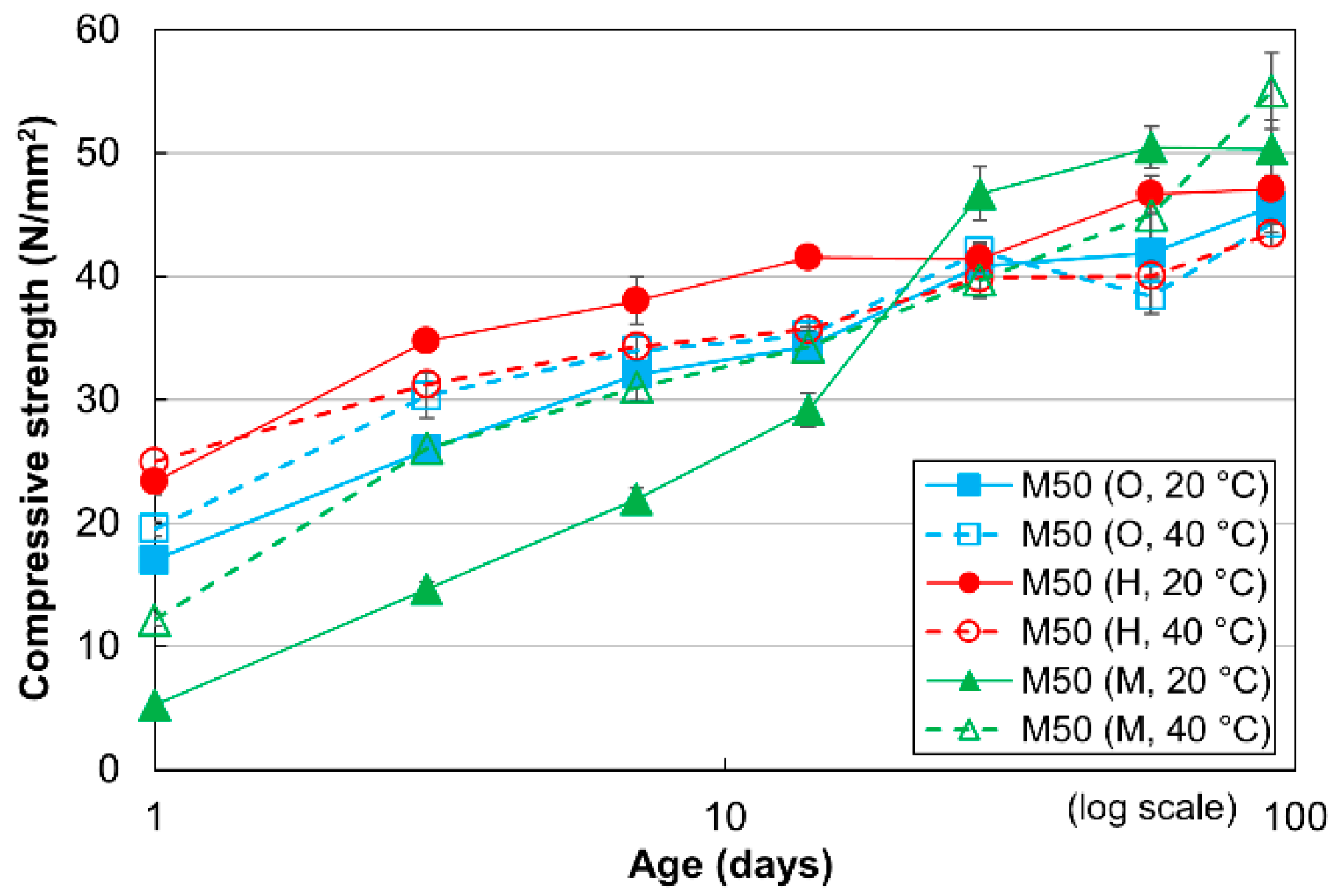



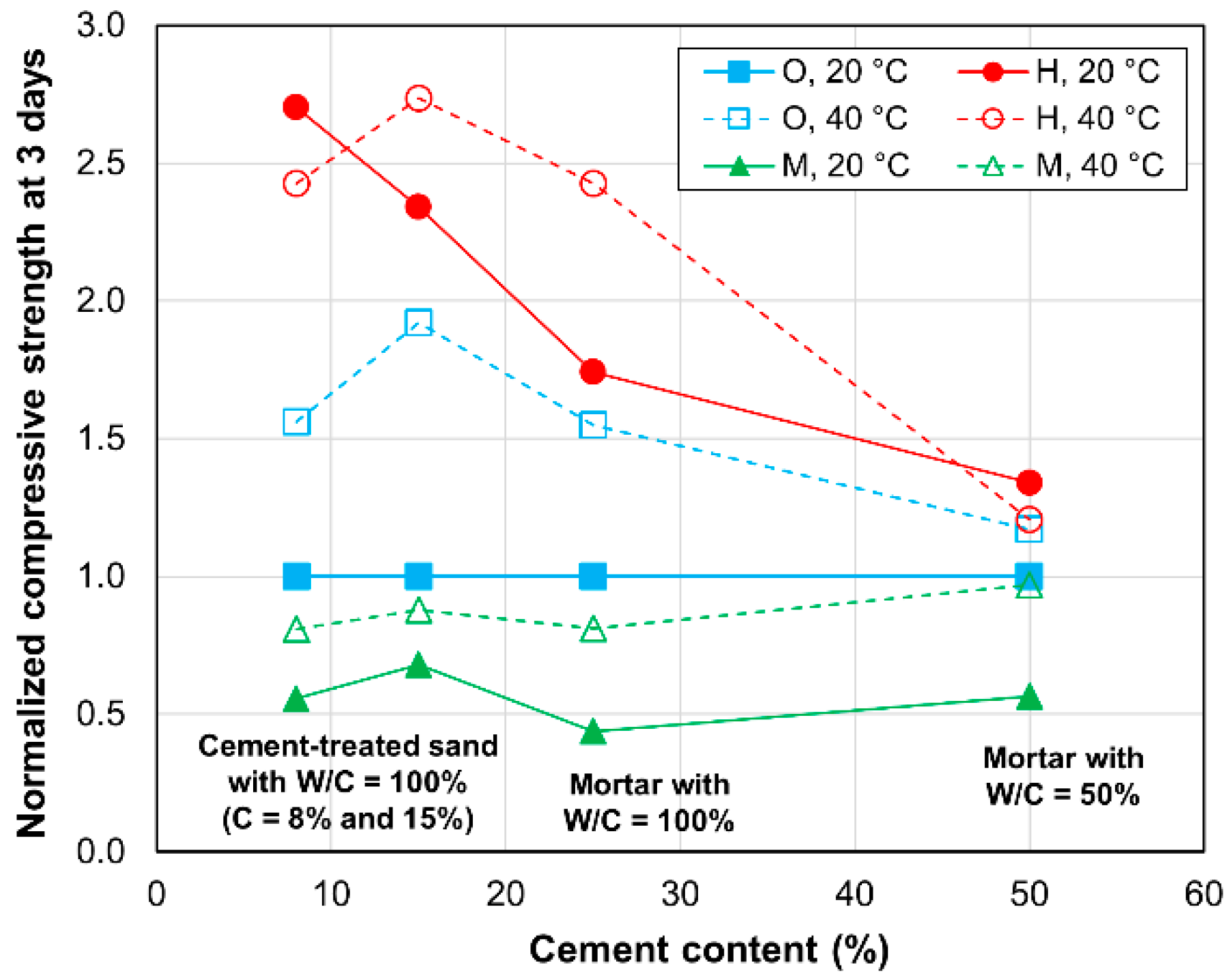
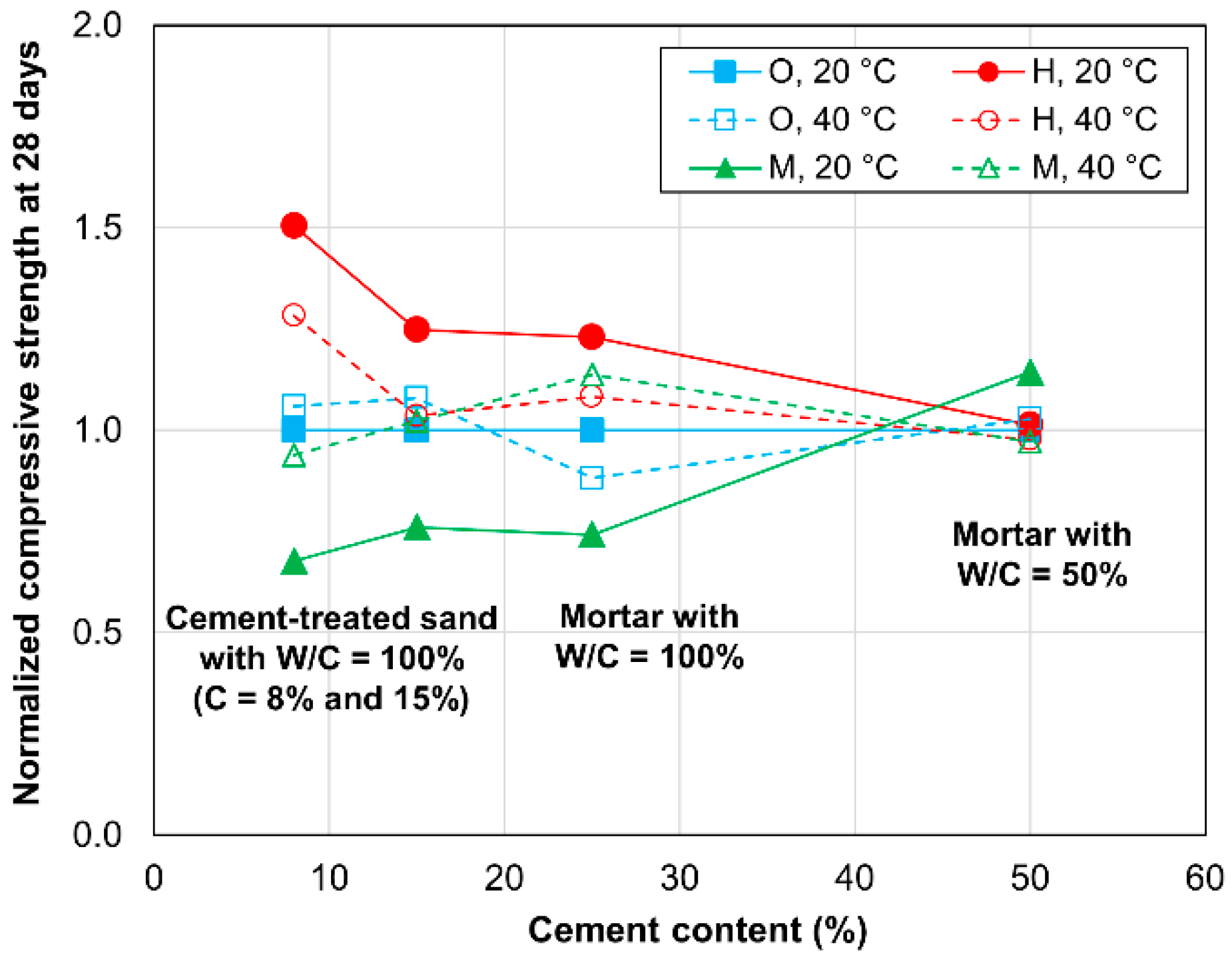


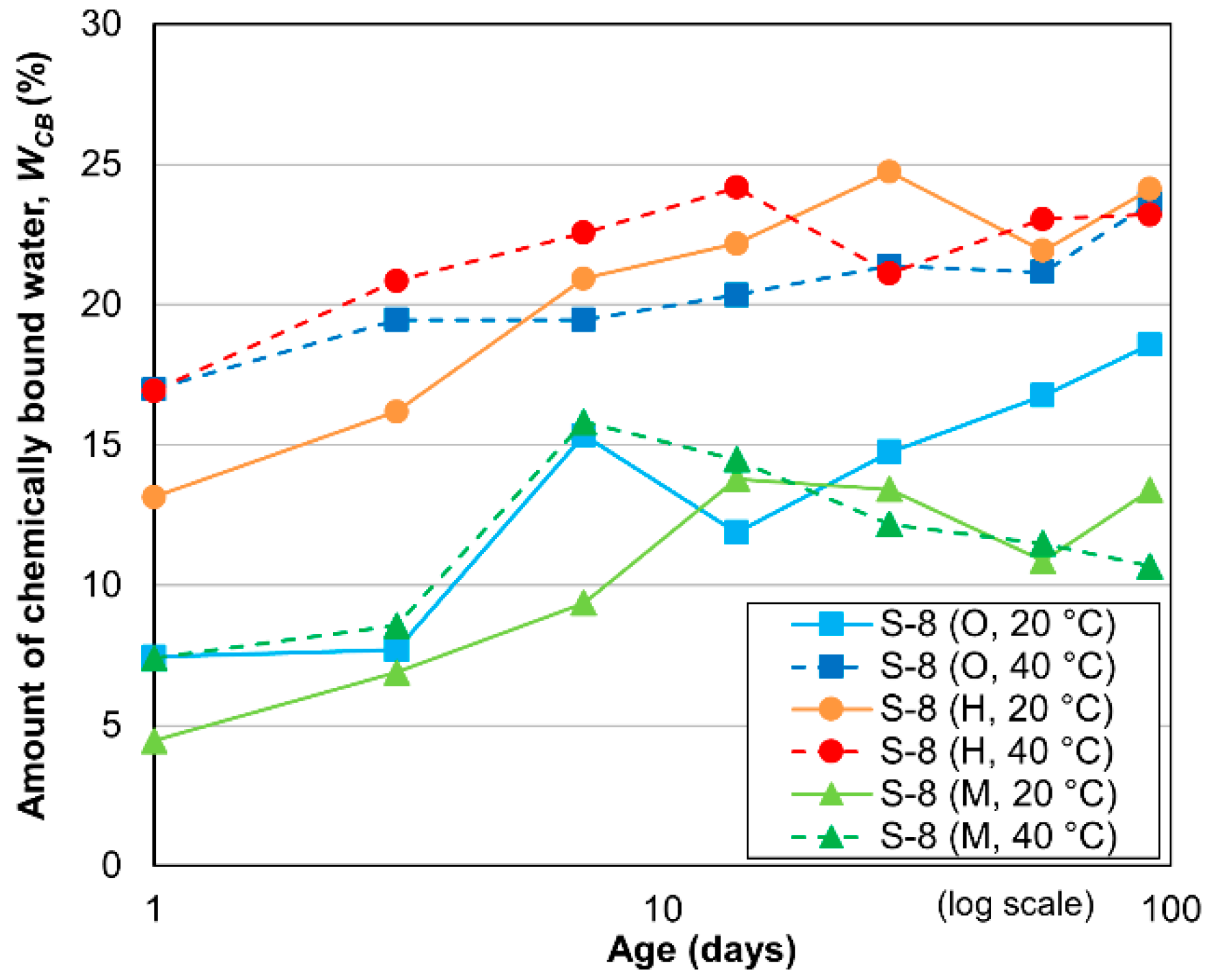
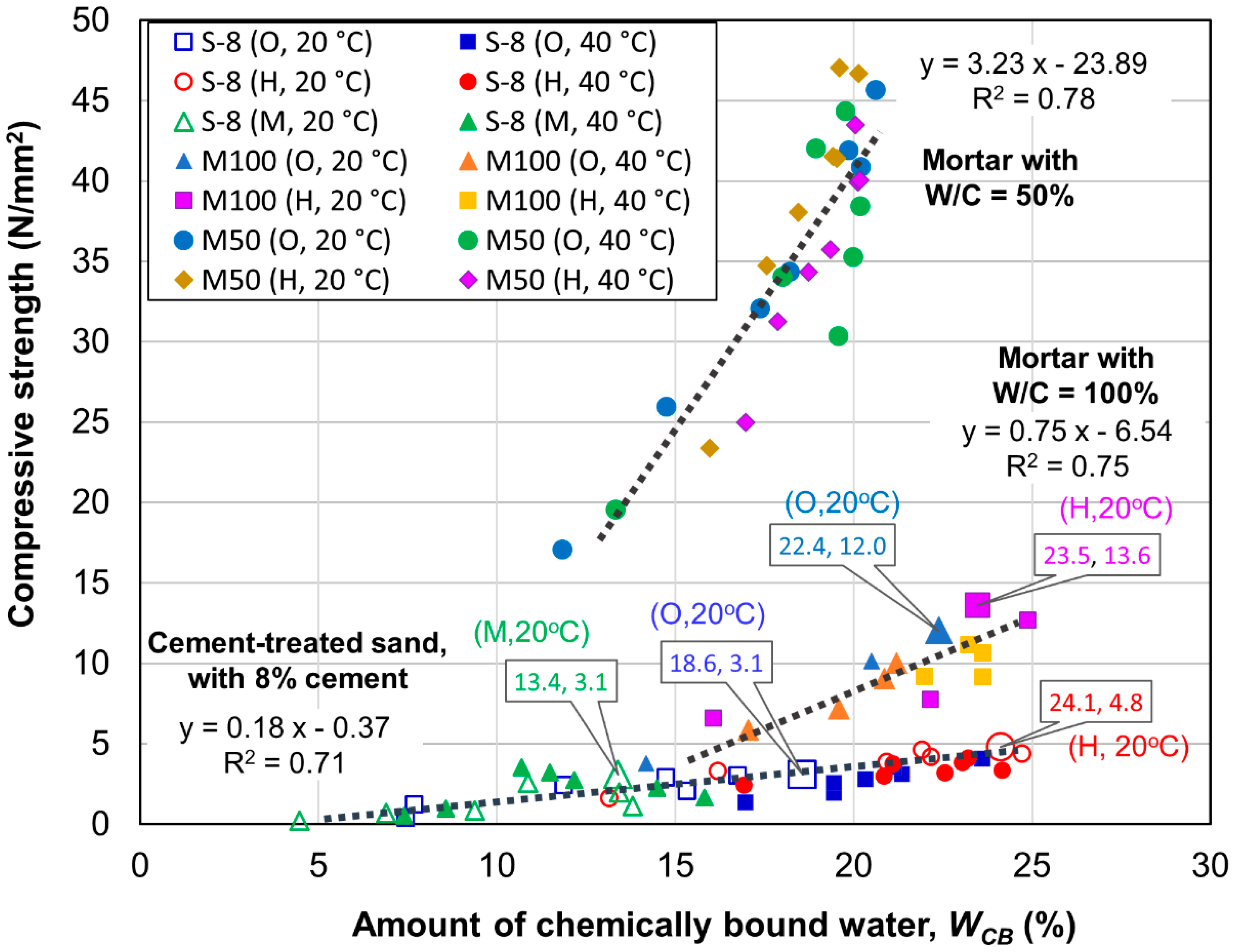
| Chemical Composition | OPC [31] | HPC | MPC | Toyoura Silica Sand [31] |
|---|---|---|---|---|
| Loss on ignition (LOI) | 2.59 | 1.57 | 0.98 | 0.37 |
| SiO2 | 20.18 | 20.19 | 23.60 | 92.54 |
| Al2O3 | 5.19 | 4.99 | 3.73 | 2.96 |
| Fe2O3 | 2.89 | 2.84 | 4.66 | 0.35 |
| CaO | 64.65 | 65.26 | 63.11 | 0.19 |
| MgO | 0.92 | 0.83 | 0.76 | 0.05 |
| SO3 | 2.10 | 3.03 | 2.06 | 0.02 |
| Na2O | 0.24 | 0.20 | 0.23 | 0.58 |
| K2O | 0.40 | 0.34 | 0.23 | 2.75 |
| Other | 0.84 | 0.75 | 0.64 | 0.19 |
| Cement Type | Calculated Mineral Component (Mass%) | ||||||
|---|---|---|---|---|---|---|---|
| C3S | C2S | C3A | C4AF | CaSO4 | CaCO3 | Others | |
| HPC | 57.80 | 14.36 | 8.42 | 8.63 | 5.15 | 3.57 | 2.06 |
| OPC | 51.35 | 19.20 | 8.87 | 8.79 | 3.57 | 5.89 | 2.34 |
| MPC | 34.82 | 41.48 | 2.01 | 14.17 | 3.50 | 2.23 | 1.80 |
| Mixture | Mixture Notation | Sand Content (kg/m3) | Cement/Sand (wt.%) | Water/Cement (W/C) (wt.%) |
|---|---|---|---|---|
| Cement-treated sand with 8% cement | S-8 (cement type *, curing temperature **) | 1450 | 8 | 100 |
| Cement-treated sand with 15% cement | S-15 (cement type, curing temperature) | 1423 | 15 | 100 |
| Mortar (W/C) = 100%) | M100 (cement type, curing temperature) | 1415 | 25 | 100 |
| Mortar (W/C = 50%) | M50 (cement type, curing temperature) | 1270 | 50 | 50 |
Publisher’s Note: MDPI stays neutral with regard to jurisdictional claims in published maps and institutional affiliations. |
© 2020 by the authors. Licensee MDPI, Basel, Switzerland. This article is an open access article distributed under the terms and conditions of the Creative Commons Attribution (CC BY) license (http://creativecommons.org/licenses/by/4.0/).
Share and Cite
Ho, L.S.; Nakarai, K.; Eguchi, K.; Ogawa, Y. Difference in Strength Development between Cement-Treated Sand and Mortar with Various Cement Types and Curing Temperatures. Materials 2020, 13, 4999. https://doi.org/10.3390/ma13214999
Ho LS, Nakarai K, Eguchi K, Ogawa Y. Difference in Strength Development between Cement-Treated Sand and Mortar with Various Cement Types and Curing Temperatures. Materials. 2020; 13(21):4999. https://doi.org/10.3390/ma13214999
Chicago/Turabian StyleHo, Lanh Si, Kenichiro Nakarai, Kenta Eguchi, and Yuko Ogawa. 2020. "Difference in Strength Development between Cement-Treated Sand and Mortar with Various Cement Types and Curing Temperatures" Materials 13, no. 21: 4999. https://doi.org/10.3390/ma13214999
APA StyleHo, L. S., Nakarai, K., Eguchi, K., & Ogawa, Y. (2020). Difference in Strength Development between Cement-Treated Sand and Mortar with Various Cement Types and Curing Temperatures. Materials, 13(21), 4999. https://doi.org/10.3390/ma13214999





